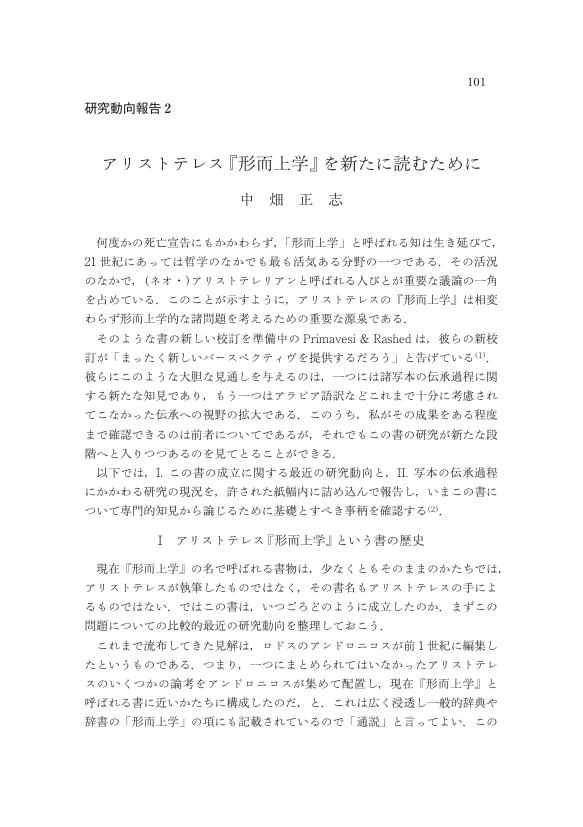11 0 0 0 因果的世界における心の位置
- 著者
- 中畑 正志
- 出版者
- The Philosophical Association of Japan
- 雑誌
- 哲学 (ISSN:03873358)
- 巻号頁・発行日
- no.47, pp.55-73, 1996
Recently some philosophers have cast doubt on the causal relevancy of the mental. In particular, they complain that functionalism and anomalous monism fail to make the mental causally efficient. However, both the critics and the defenders of these views share a common picture of causation that generates the problem of mental causation : they sharply contrast causation with normativity or rationality and take it to be prior to and independent of our explanatory practice. Rejecting this assumption, this paper argues that there is a deep connection between psychological explanation and the attribution of causal powers of the mental.
5 0 0 0 OA 見ていることを感覚する
- 著者
- 中畑 正志
- 出版者
- 日本哲学会
- 雑誌
- 哲学 (ISSN:03873358)
- 巻号頁・発行日
- vol.2013, no.64, pp.78-102_L8, 2013 (Released:2014-07-10)
- 参考文献数
- 44
The phenomenon described as “perceiving that one sees” or “perception of one's own perception” has attracted the attention of many philosophers. In this article, I articulate the differences between Aristotle's and Descartes' understanding of this phenomenon, with brief comments on the discussion of the same phenomenon in the Cyrenaics, Stoics and Plotinus.In several passages Aristotle explores this phenomenon, i. e. “perceiving that one sees.” We should pay special attention to the fact that in De somno, Aristotle assumes that trans-modal discrimination (such as discrimination of sweet from white) implies this sort of higher order perception. We can explain this implication as follows: when we discriminate, for example, sweet from white, we also discriminate the respective modes of perception, namely, tasting in the perception of sweet on the one hand and seeing in the perception of white on the other. This means that Aristotle understands perceiving that one sees as an integral part of the first order perception of the external thing. This is why this second order recognition is a kind of sense-perception par excellence for Aristotle.Descartes elucidates the phenomenon of perceiving that one sees in an opposite way from Aristotle. He separates this phenomenon from the external object that one perceives. Descartes restricts the sense-perception within one’s subjective experience and counts it as a mode of thought. This is sense-perception in its proper (praecise) sense for Descartes and what he calls conscientia (consciousness). Descartes broke the Aristotelian unity between our inner activity and its external objects, and the Cartesian concept of consciousness is a historical product of this break. By examining the explanations of the same phenomenon expounded by the Cyrenaics, Stoics and Plotinus, we can confirm its historicity.
1 0 0 0 OA アリストテレス『形而上学』を新たに読むために
- 著者
- 中畑 正志
- 出版者
- 日本西洋古典学会
- 雑誌
- 西洋古典学研究 (ISSN:04479114)
- 巻号頁・発行日
- vol.68, pp.101-114, 2020 (Released:2023-05-19)
1 0 0 0 オッカムへの「脚注」の試み (特集2 オッカム論理学の位相)
- 著者
- 中畑 正志
- 出版者
- 創文社
- 雑誌
- 創文 (ISSN:13436147)
- 巻号頁・発行日
- no.483, pp.24-26, 2006-01
1 0 0 0 アリストテレスの言い分--倫理的な知のあり方をめぐって
- 著者
- 中畑 正志
- 出版者
- 古代哲学会
- 雑誌
- 古代哲学研究 (ISSN:03865002)
- 巻号頁・発行日
- no.42, pp.1-30, 2010
- 著者
- 中畑 正志
- 出版者
- 有斐閣
- 雑誌
- 哲学雑誌 (ISSN:03873366)
- 巻号頁・発行日
- vol.131, no.803, pp.53-75, 2016
1 0 0 0 見ていることを感覚する:共通の感覚、内的感覚、そして意識
- 著者
- 中畑 正志
- 出版者
- The Philosophical Association of Japan
- 雑誌
- 哲学 (ISSN:03873358)
- 巻号頁・発行日
- vol.2013, no.64, pp.78-102_L8, 2013
The phenomenon described as "perceiving that one sees" or "perception of one's own perception" has attracted the attention of many philosophers. In this article, I articulate the differences between Aristotle's and Descartes' understanding of this phenomenon, with brief comments on the discussion of the same phenomenon in the Cyrenaics, Stoics and Plotinus.<br>In several passages Aristotle explores this phenomenon, i. e. "perceiving that one sees." We should pay special attention to the fact that in <i>De somno</i>, Aristotle assumes that trans-modal discrimination (such as discrimination of sweet from white) implies this sort of higher order perception. We can explain this implication as follows: when we discriminate, for example, sweet from white, we also discriminate the respective modes of perception, namely, <i>tasting</i> in the perception of sweet on the one hand and <i>seeing</i> in the perception of white on the other. This means that Aristotle understands perceiving that one sees as an integral part of the first order perception of the external thing. This is why this second order recognition is a kind of sense-perception <i>par excellence</i> for Aristotle.<br>Descartes elucidates the phenomenon of perceiving that one sees in an opposite way from Aristotle. He <i>separates</i> this phenomenon from the external object that one perceives. Descartes restricts the sense-perception within one's subjective experience and counts it as a mode of thought. This is sense-perception in its proper (<i>praecise</i>) sense for Descartes and what he calls <i>conscientia</i> (consciousness). Descartes broke the Aristotelian unity between our inner activity and its external objects, and the Cartesian concept of consciousness is a historical product of this break. By examining the explanations of the same phenomenon expounded by the Cyrenaics, Stoics and Plotinus, we can confirm its historicity.
